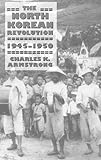The North Korean Revolution, 1945–1950 / Charles K. Armstrong.
Material type: TextSeries: Studies of the Weatherhead East Asian Institute, Columbia UniversityPublisher: Ithaca, NY : Cornell University Press, [2013]Copyright date: ©2013Description: 1 online resource (288 p.) : 1 map, 14 halftones, 12 tablesContent type:
TextSeries: Studies of the Weatherhead East Asian Institute, Columbia UniversityPublisher: Ithaca, NY : Cornell University Press, [2013]Copyright date: ©2013Description: 1 online resource (288 p.) : 1 map, 14 halftones, 12 tablesContent type: - 9780801468803
- 951.9304/1
- online - DeGruyter
| Item type | Current library | Call number | URL | Status | Notes | Barcode | |
|---|---|---|---|---|---|---|---|
 eBook
eBook
|
Biblioteca "Angelicum" Pont. Univ. S.Tommaso d'Aquino Nuvola online | online - DeGruyter (Browse shelf(Opens below)) | Online access | Not for loan (Accesso limitato) | Accesso per gli utenti autorizzati / Access for authorized users | (dgr)9780801468803 |
Frontmatter -- Contents -- List of Illustrations -- Acknowledgments -- List of Abbreviations -- Introduction -- 1. Revolution on the Margins -- 2. Liberation, Occupation, and the Emerging New Order -- 3. Remaking the People -- 4. Coalition Politics and the United Front -- 5. Planning the Economy -- 6. Constructing Culture -- 7. A Regime of Surveillance -- 8. The People’s State -- Conclusion -- Appendix A: A Note on Sources -- Appendix B: Statements of General Chistiakov on the Soviet Occupation of North Korea, Fall 1945 -- Selected Bibliography -- Index
restricted access online access with authorization star
http://purl.org/coar/access_right/c_16ec
North Korea, despite a shattered economy and a populace suffering from widespread hunger, has outlived repeated forecasts of its imminent demise. Charles K. Armstrong contends that a major source of North Korea's strength and resiliency, as well as of its flaws and shortcomings, lies in the poorly understood origins of its system of government. He examines the genesis of the Democratic People's Republic of Korea (DPRK) both as an important yet rarely studied example of a communist state and as part of modern Korean history.North Korea is one of the last redoubts of "unreformed" Marxism-Leninism in the world. Yet it is not a Soviet satellite in the East European manner, nor is its government the result of a local revolution, as in Cuba and Vietnam. Instead, the DPRK represents a unique "indigenization" of Soviet Stalinism, Armstrong finds. The system that formed under the umbrella of the Soviet occupation quickly developed into a nationalist regime as programs initiated from above merged with distinctive local conditions. Armstrong's account is based on long-classified documents captured by U.S. forces during the Korean War. This enormous archive of over 1.6 million pages provides unprecedented insight into the making of the Pyongyang regime and fuels the author's argument that the North Korean state is likely to remain viable for some years to come.
Mode of access: Internet via World Wide Web.
In English.
Description based on online resource; title from PDF title page (publisher's Web site, viewed 26. Apr 2024)


